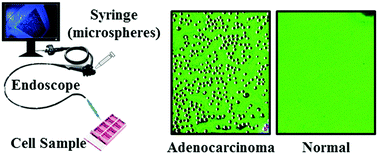当前位置:
X-MOL 学术
›
Integr. Biol.
›
论文详情
Our official English website, www.x-mol.net, welcomes your feedback! (Note: you will need to create a separate account there.)
An adhesion based approach for the detection of esophageal cancer.
Integrative Biology ( IF 2.5 ) Pub Date : 2018-12-19 , DOI: 10.1039/c8ib00132d Mahboubeh S Noori 1 , Evan S Streator , Grady E Carlson , David S Drozek , Monica M Burdick , Douglas J Goetz
Integrative Biology ( IF 2.5 ) Pub Date : 2018-12-19 , DOI: 10.1039/c8ib00132d Mahboubeh S Noori 1 , Evan S Streator , Grady E Carlson , David S Drozek , Monica M Burdick , Douglas J Goetz
Affiliation

|
Esophageal cancer has a 5 year survival rate of ∼20%. This dismal prognosis is due, in part, to the fact that esophageal cancer often presents at a late stage. Thus, there is a critical need for assays that enable the early detection of cancerous tissue within the esophagus. The luminal surface of the esophagus expresses signature molecule(s) at sites of transformation providing an avenue for the development of in situ assays that detect neoplastic growth within the esophagus. An attractive approach, receiving increased attention, is the endoscopic administration of particles conjugated with ligands to signature molecules present on transforming tissue. Detection of the particles within the esophagus, post-washing, would indicate the presence of the signature molecule and thus transforming tissue. In this work, we utilized cancerous and normal esophageal cells to provide in vitro proof of principle for this approach utilizing ligand-conjugated microspheres and demonstrate the need, and provide the framework for, engineering this technology. Specifically, the study (i) reveals selective increased expression of signature molecules on cancerous esophageal cells relative to normal cells; (ii) demonstrates selective binding of ligand-conjugated microspheres to cancerous esophageal cells relative to normal cells; (iii) demonstrates that the selective recognition of cancerous, relative to normal esophageal cells, is highly dependent on the biophysical design of the assay; and (iv) advocates utilizing the knowledge from the field of cell adhesion as a guide for the effective development of ligand-conjugated particle-based schemes that seek to detect esophageal oncogenesis in situ.
中文翻译:

一种基于粘着力的食管癌检测方法。
食道癌的5年生存率约为20%。这种令人沮丧的预后部分是由于食管癌通常在晚期才出现。因此,迫切需要能够早期检测食道内癌组织的测定法。食道的腔表面在转化位点表达一个或多个标志性分子,这为开发检测食道内肿瘤生长的原位分析提供了途径。受到越来越多关注的一种有吸引力的方法是,将与配体缀合的颗粒内窥镜给药到存在于转化组织上的标志分子上。清洗后在食道内检测到颗粒将表明特征分子的存在,从而转化组织。在这项工作中,我们利用癌细胞和正常的食道细胞,利用结合了配体的微球体为该方法提供了体外原理证明,并证明了对该技术进行工程改造的必要性并提供了框架。具体来说,这项研究(i)发现相对于正常细胞,食管癌细胞上签名分子的选择性表达增加;(ii)证明相对于正常细胞,配体缀合的微球与食道癌细胞的选择性结合;(iii)证明相对于正常的食道细胞,癌变的选择性识别高度依赖于该测定法的生物物理设计;
更新日期:2018-11-06
中文翻译:

一种基于粘着力的食管癌检测方法。
食道癌的5年生存率约为20%。这种令人沮丧的预后部分是由于食管癌通常在晚期才出现。因此,迫切需要能够早期检测食道内癌组织的测定法。食道的腔表面在转化位点表达一个或多个标志性分子,这为开发检测食道内肿瘤生长的原位分析提供了途径。受到越来越多关注的一种有吸引力的方法是,将与配体缀合的颗粒内窥镜给药到存在于转化组织上的标志分子上。清洗后在食道内检测到颗粒将表明特征分子的存在,从而转化组织。在这项工作中,我们利用癌细胞和正常的食道细胞,利用结合了配体的微球体为该方法提供了体外原理证明,并证明了对该技术进行工程改造的必要性并提供了框架。具体来说,这项研究(i)发现相对于正常细胞,食管癌细胞上签名分子的选择性表达增加;(ii)证明相对于正常细胞,配体缀合的微球与食道癌细胞的选择性结合;(iii)证明相对于正常的食道细胞,癌变的选择性识别高度依赖于该测定法的生物物理设计;



























 京公网安备 11010802027423号
京公网安备 11010802027423号